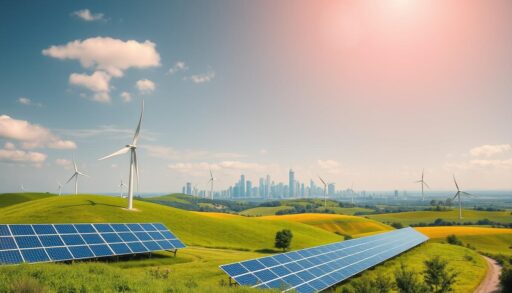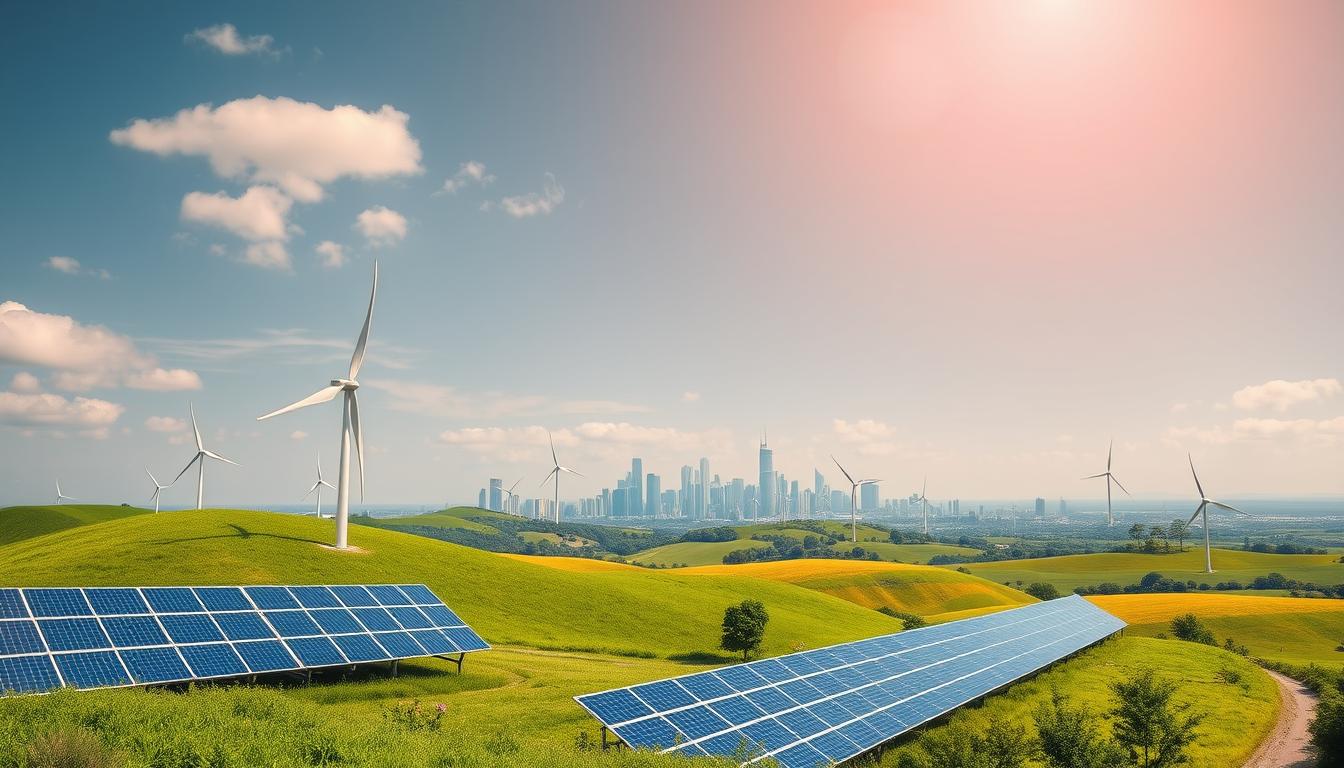Climate change is a harsh reality, causing millions of deaths and trillions in losses over 50 years. We must switch from fossil fuels to cleaner energy. This change is urgent and focuses on fairness in energy access. The energy transition aims to use sustainable, green energy solutions.
This shift is driven by growing awareness, new technologies, and economic benefits. It also depends on policies and the impact of climate disasters.
Successfully moving to cleaner energy faces many challenges. We need to tackle technical, economic, and social hurdles. Stakeholders like utilities, governments, and NGOs play crucial roles.
The energy sector’s future looks different. Renewable energy like solar, wind, and hydropower will lead. Advances in technology, energy storage, and smart grids will support this change.
Key Takeaways
- The energy transition is a critical shift from fossil fuels to renewable and cleaner energy sources, driven by the need for sustainable and environmentally friendly energy solutions.
- Extreme weather events and the growing awareness of climate change have increased the urgency for this energy transition.
- Technological advancements, economic feasibility, policy frameworks, and societal demand are key drivers of the energy transition.
- Navigating the energy transition requires addressing technical, economic, and societal challenges, as well as the roles of various stakeholders.
- The future energy mix is expected to be dominated by renewable energy sources like solar, wind, and hydropower, supported by technological breakthroughs in energy storage and smart grid technology.
Understanding the Energy Transition
The energy industry has changed a lot in recent years. It’s moving from fossil fuels to renewable energy. This change is important for our planet and helps us use energy in a better way.
Transition from Fossil Fuels to Renewable Energy
For over a century, fossil fuels like coal, oil, and gas ruled the energy world. But in the last 15 years, we’ve seen a big jump in using renewable energy. This includes solar, wind, and hydropower. People are now more aware of the harm fossil fuels cause and want to fight climate change.
Urgency of Addressing Climate Change
The burning of fossil fuels has led to a lot of carbon dioxide in our atmosphere. This has caused severe weather like droughts, floods, and wildfires. We need to switch to renewable energy to cut down on these emissions and protect our planet.
| Renewable Energy Technology | Recent Developments |
|---|---|
| Solar Energy | In the Netherlands, solar energy saw a 50% year-on-year increase in installed capacity, reaching 4,400 megawatts in 2018. Commercial rooftop solar installations contributed about 530 megawatts out of the total increase. |
| Wind Energy | Offshore wind energy is gaining traction, with industry projections indicating greater offshore focus in 2021. Turbines are being designed with higher capacity to enhance efficiency, and oil and gas companies are increasingly investing in offshore wind projects as part of their transition to low-carbon businesses. |
| Hydrogen | Development of green hydrogen is on the rise, with power-to-gas projects aiming to produce hydrogen through electrolysis using renewable electricity sources. This method not only tackles carbon emissions but also supports renewable energy integration and aids in gas decarbonization efforts. |
The energy transition is key to a greener future. We must act fast to tackle climate change challenges.
Key Drivers of the Energy Transition
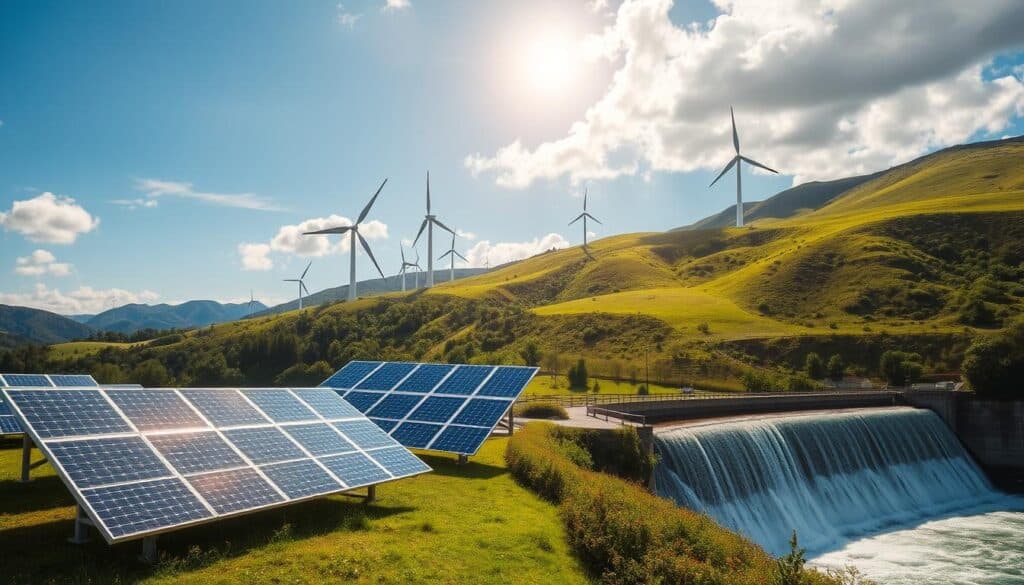
The energy transition is moving forward thanks to technology, cost, and policy changes. New solar and wind technologies are making clean energy cheaper and more efficient. The market for renewable energy is growing fast, with more investment and incentives.
Technological Advancements in Renewable Energy
Renewable energy tech has made big strides. In 2023, we saw a lot of growth in solar, electric cars, and heat pumps. Wind power also grew a lot in 2022, showing it’s becoming more viable.
New tech is making renewable energy better and cheaper. This makes it easier for people and businesses to use.
Economic Feasibility and Market Dynamics
The cost of renewable energy is dropping. Heat pumps and electric cars are getting cheaper. This makes them more appealing to consumers.
The green bond market has hit $1 trillion since 2007. This shows a big jump in investment in sustainable projects.
Policy and Regulatory Frameworks
Government policies are key to the energy shift. The Paris Agreement sets targets for cutting emissions. This pushes countries to use more sustainable energy.
Policies like carbon pricing and subsidies help renewable energy grow. They create a good environment for clean energy adoption.
Technology, cost, and policy are pushing us towards a greener future. This could lead to big cuts in greenhouse gas emissions and help meet global climate goals.
Renewable Energy Technologies
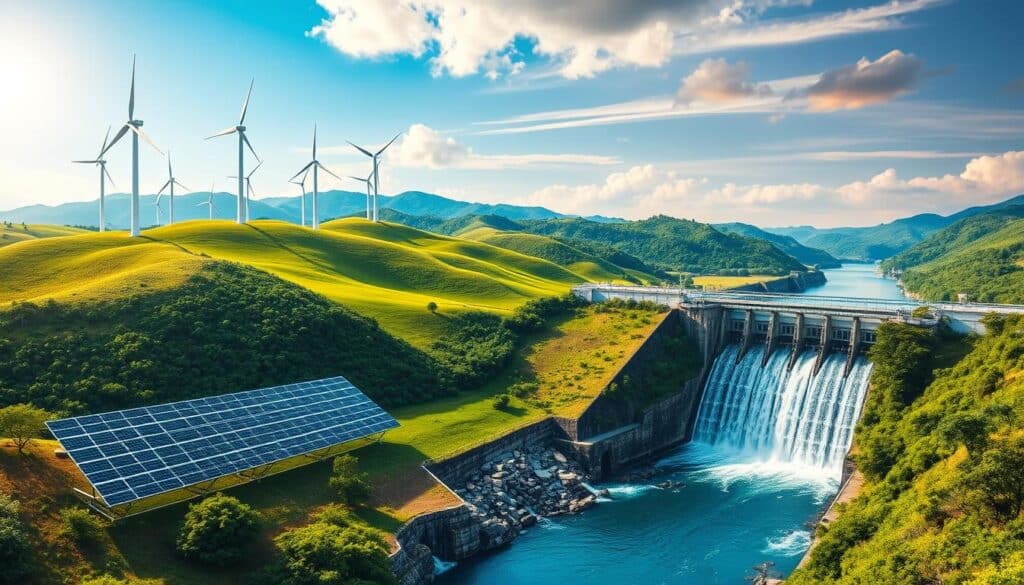
New renewable energy technologies are leading the energy transition. These include solar photovoltaic (PV) systems, wind energy, and energy storage solutions. They are changing the global energy scene, making it greener and more efficient.
Solar Photovoltaic (PV) Systems
Solar PV systems have grown fast in recent years. They use sunlight to make clean electricity. You can install them on rooftops or in open fields.
Thanks to new tech, solar PV is now cheaper and more efficient. It’s great for homes, businesses, and big power plants.
Wind Energy
Wind energy is also on the rise. Wind turbines turn wind into electricity. This is a reliable, green power source.
Wind energy needs good wind and space. But it’s popular in areas with strong winds.
Energy Storage Solutions
- Energy storage, like batteries, helps with the ups and downs of renewable energy. It makes the grid more reliable.
- Batteries paired with renewables offer affordable, reliable power. This is key for isolated areas and off-grid communities.
- Energy storage tech is getting better. It’s more efficient, scalable, and affordable. This is vital for a sustainable energy future.
These renewable energy technologies are getting better and cheaper. They’re key for a sustainable energy future. As the energy system changes, these solutions will be crucial for a cleaner, more efficient energy world.
“Transitioning subsidies from fossil fuels to renewable energy sources not only reduces emissions but also supports sustainable economic growth, job creation, public health improvement, and greater equality among communities globally.”
Energy Transition: Challenges and Strategies
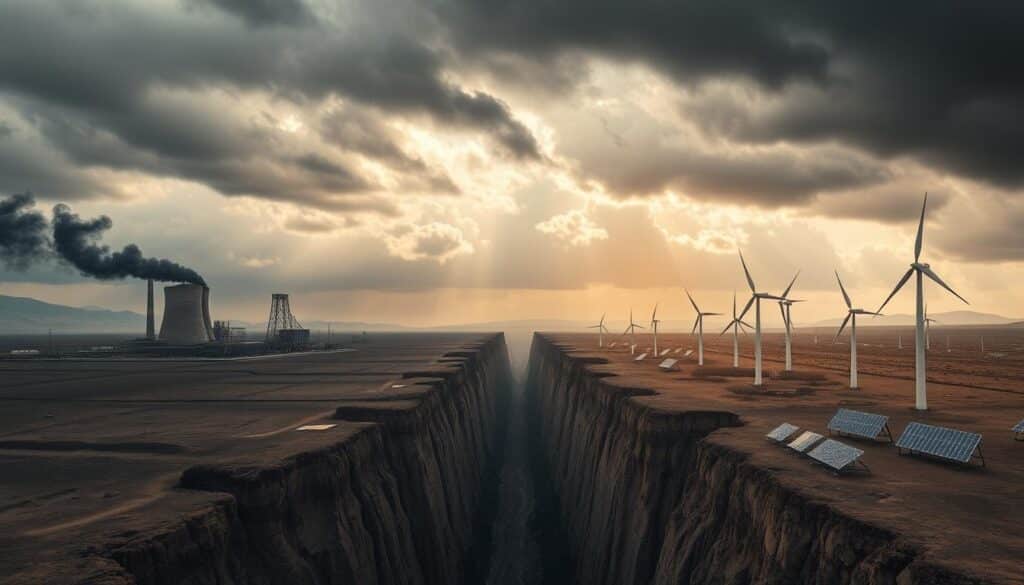
As we move towards renewable energy, we face many challenges. These include both technical and economic hurdles. We need solid strategies to tackle these issues.
Technical Challenges: Energy Storage and Grid Reliability
One big challenge is finding efficient ways to store energy. Solar and wind power are not always available. We need better storage, like batteries, to keep the energy flowing smoothly.
Also, adding renewable energy to our grid is tricky. It can make the grid unstable. We need new ways to manage the grid and upgrade it to keep the power on.
Economic Challenges: Investments and Market Dynamics
The cost of switching to renewable energy is high. It takes a lot of money for new tech and infrastructure. We need to find ways to make it cheaper, like using government incentives.
Changes in energy prices and new business models also add to the problem. We must find ways to make renewable energy more competitive.
| Technical Challenges | Economic Challenges |
|---|---|
| Energy Storage | Investments |
| Grid Reliability | Market Dynamics |
| Intermittency of Renewable Sources | Subsidies and Incentives |
| Grid Integration and Management | Financing Options |
Beating these challenges will take teamwork. We need policymakers, industry leaders, and researchers working together. They must find new solutions and make the rules easier to follow.
“The transition to renewable energy is essential for a sustainable future, but it is not without its challenges. Addressing these technical and economic hurdles will require a comprehensive and coordinated approach to ensure the success of the energy transition.”
The Role of Stakeholders
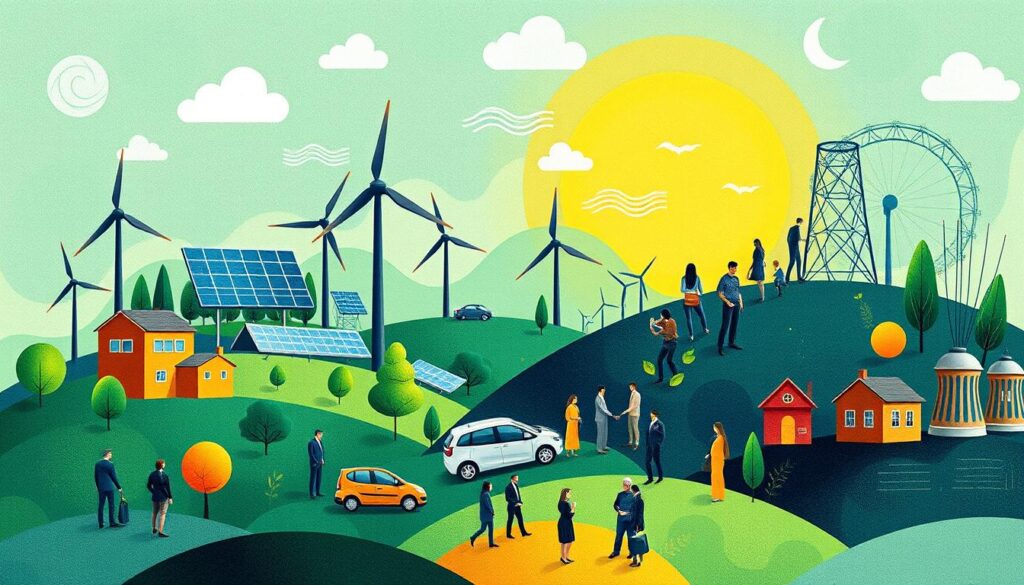
The move towards a sustainable future needs many stakeholders. Utilities are key, changing their ways to fit in new energy sources. They must keep the grid stable and reliable.
Governments play a big role too. They make rules that help use more renewable energy. They also set goals to cut down on emissions. Companies in the energy field are also important. They help bring new, green technologies to life.
Utilities and Grid Integration
Utilities have to make things affordable and fair while adding new energy sources. They need to spend a lot on updating the grid. This includes new storage and ways to manage energy use.
Collaboration among Governments, Enterprises, and NGOs
Working together is key. Governments, companies, and NGOs need to team up. They should support each other to push the energy change forward. This means working on policies, finding money, and starting green projects.
| Stakeholder | Role in Energy Transition |
|---|---|
| Utilities | Grid integration, renewable energy adoption, business model transformation |
| Governments | Policy and regulatory frameworks, emissions reduction targets, investment incentives |
| Enterprises | Sustainable technology development and deployment, investment decisions |
| NGOs | Advocacy, research, and implementation of sustainable energy projects |
Working together can speed up the energy change. It helps renewable energy grow. This leads to a greener future for all.
Energy Transition and Energy Equity

The energy transition is making energy equity a big issue. It’s important to make sure everyone gets a fair share of the clean energy benefits. This means fighting energy poverty, supporting inclusive policies, and helping workers and communities during the change.
We need to make the energy transition work for everyone. This means focusing on sustainable development and helping those who are disadvantaged. It can lead to better jobs, economic growth, and a higher quality of life for everyone.
- Studies have shown how the energy transition can hurt certain communities and groups.
- Terms like energy justice and equity are being talked about a lot. They aim to make sure everyone gets a fair chance in the switch to sustainable energy.
- There have been studies on the effects of closing coal-fired power plants, especially in places like Appalachian Ohio.
- Reports have looked at how clean energy jobs are growing in America. They highlight the need to support workers and communities moving away from fossil fuels.
The energy transition brings both challenges and chances. By focusing on energy equity, access, and a just transition, we can help marginalized communities. This will lead to sustainable development and a brighter, more inclusive energy future for everyone.
“The energy transition must be designed and implemented in a manner that prioritizes sustainable development and the empowerment of disadvantaged groups, creating opportunities for economic growth, job creation, and improved quality of life for all.”
Future Outlook: Shift in Global Energy Mix
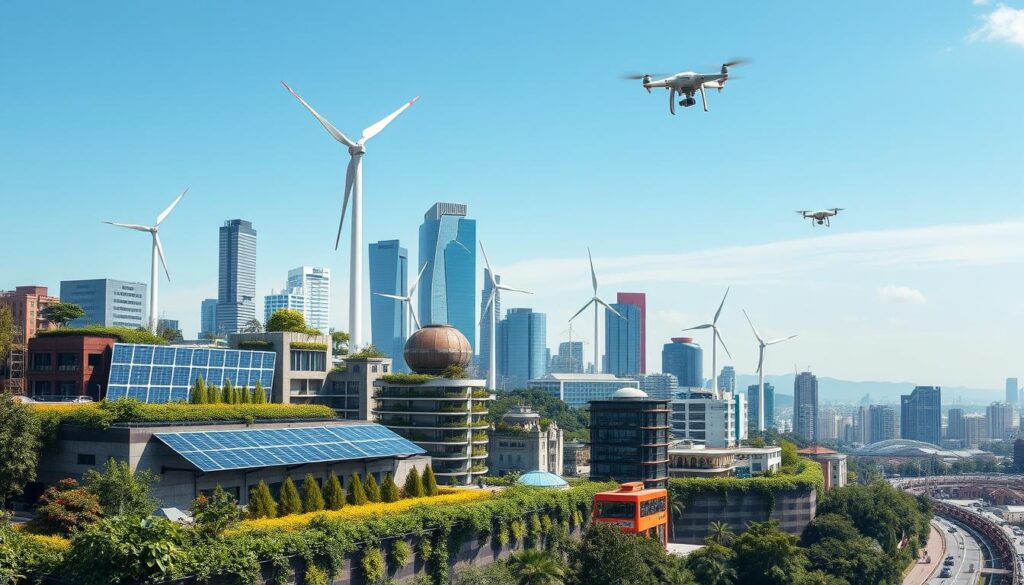
The global energy landscape is set for a big change. This change comes from the growing use of renewable energy. New technologies and cheaper clean energy are changing how we make, store, and share power.
Technological Breakthroughs: Next-Generation Renewables and Smart Grids
New renewable energy tech, like solar and wind, will lead the way to a greener future. Solar power is expected to beat the US’s current power output by 2030. Solar panel making could hit 1,200 GW by the end of the decade.
Smart grid tech is also changing the game. It makes energy distribution and management better. Smart grids use digital tech to improve grid stability and use more renewable energy. This makes the energy system more reliable and green.
| Key Projected Trends by 2030 | Data |
|---|---|
| Increase in Electric Vehicles | Almost 10 times as many electric cars on the road worldwide compared to present numbers |
| Growth in Renewable Energy Generation | Renewables expected to account for almost 50% of the global electricity mix, up from around 30% currently |
| Decline in Fossil Fuel Demand | The share of fossil fuels in global energy supply projected to decline from about 80% to 73% |
| Reduction in Emissions | Global energy-related CO2 emissions expected to peak by 2025 |
As tech improves, the energy mix will change a lot. Renewables will be the main power source for our future. This change, along with better energy storage and grid tech, will help us move to a cleaner, stronger, and greener energy world.
Also Read : What Is A Global MBA In Sustainability And Why Is It Important?
Conclusion
The energy transition is a big step towards a sustainable future. It’s driven by our need for clean energy, new tech, and good policies. This shift from old to new energy sources is key to fighting climate change.
It’s not easy, but we can do it with everyone’s help. Utilities, governments, businesses, and NGOs all play a part. Together, we can overcome challenges and make a change.
Renewable energy is becoming more important in our energy mix. New tech in solar, wind, and storage will help us move faster. This change is crucial for our planet and future generations.
To succeed, we need new policies and more jobs in clean energy. We also need support from the wealthy to help everyone. Making sure everyone has access to energy is also vital.
FAQs
Q: What is the current energy transition?
A: The current energy transition refers to the global shift from traditional fossil fuel-based energy systems to more sustainable and renewable energy sources such as solar, wind, and hydroelectric power. This transition aims to reduce carbon emissions and enhance energy efficiency across the energy sector.
Q: How can clean energy technologies help in the energy transition?
A: Clean energy technologies play a crucial role in the energy transition by improving energy efficiency, reducing greenhouse gas emissions, and providing sustainable energy alternatives. These technologies include solar panels, wind turbines, and energy storage systems that facilitate the deployment of renewable energy sources.
Q: What are some examples of renewable energy sources?
A: Renewable energy sources include solar energy, wind energy, hydroelectric power, geothermal energy, and biomass. These sources are considered sustainable as they replenish naturally and contribute to the reduction of reliance on fossil fuels in the global energy sector.
Q: How does energy demand impact the energy transition?
A: Energy demand significantly influences the energy transition by determining the types of energy sources that need to be deployed. As the demand for clean energy increases, it drives investments in renewable energy projects and technologies, accelerating the transition towards a more sustainable energy system.
Q: What is the role of the International Energy Agency in the energy transition?
A: The International Energy Agency (IEA) provides analysis and policy recommendations to support the global energy transition. It publishes reports, such as the Irena’s World Energy Transitions Outlook, which outlines strategies for increasing energy efficiency, promoting renewable energy, and addressing energy consumption trends worldwide.
Q: Why is energy investment important for the future energy market?
A: Energy investment is crucial for the future energy market as it funds the development of clean energy technologies, infrastructure, and renewable energy projects. Increased investment is necessary to enhance energy production capacity, improve energy resources, and ensure a reliable transition towards low-carbon energy systems.
Q: What challenges does the world energy system face during the energy transition?
A: The world energy system faces several challenges during the energy transition, including the need for significant investments, the integration of variable renewable energy sources, the upgrading of energy infrastructure, and the management of energy consumption patterns. Addressing these challenges is essential for a successful transition.
Q: How can we accelerate the energy transition?
A: To accelerate the energy transition, stakeholders can implement energy policies that promote renewable energy deployment, invest in clean energy technologies, encourage energy efficiency measures, and facilitate international collaboration on energy projects. Public awareness and support for sustainable practices also play a vital role.
Q: What is the significance of low-carbon energy in the global energy transition?
A: Low-carbon energy is significant in the global energy transition as it helps to mitigate climate change by reducing greenhouse gas emissions. Transitioning to low-carbon energy sources is essential for achieving sustainability goals and ensuring a healthier environment for future generations.

